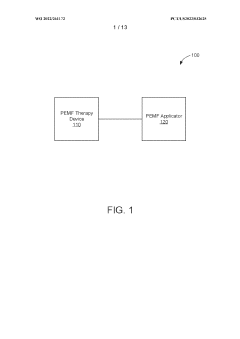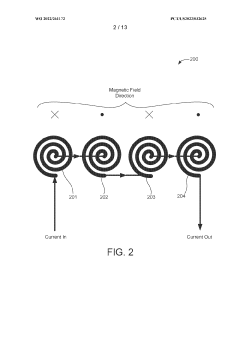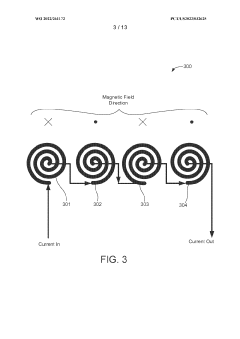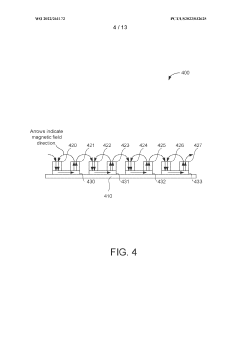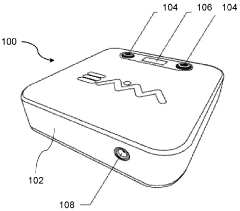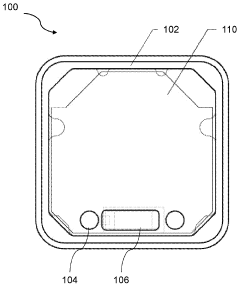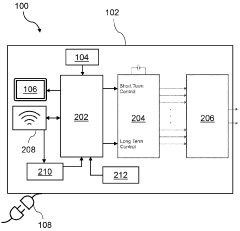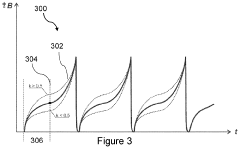How to Apply PEMF Therapy for Optimized Cellular Functions?
AUG 11, 20259 MIN READ
Generate Your Research Report Instantly with AI Agent
Patsnap Eureka helps you evaluate technical feasibility & market potential.
PEMF Therapy Background and Objectives
Pulsed Electromagnetic Field (PEMF) therapy has emerged as a promising non-invasive treatment modality, leveraging the interaction between electromagnetic fields and biological systems. The technology's roots can be traced back to the mid-20th century, with significant advancements in recent decades. PEMF therapy aims to stimulate cellular functions by applying low-frequency electromagnetic fields to the body, potentially promoting healing, reducing inflammation, and enhancing overall cellular health.
The evolution of PEMF therapy has been marked by continuous refinement in device design, treatment protocols, and understanding of its biological effects. Initially used primarily for bone healing, its applications have expanded to encompass a wide range of medical conditions, including pain management, wound healing, and neurological disorders. This expansion reflects the growing recognition of the fundamental role of electromagnetic fields in cellular processes and the potential for therapeutic manipulation of these fields.
The primary objective of PEMF therapy in optimizing cellular functions is to enhance the body's natural healing mechanisms at the cellular level. This involves improving cellular energy production, promoting better circulation, and facilitating the exchange of nutrients and waste products across cell membranes. By influencing these fundamental cellular processes, PEMF therapy aims to create an optimal environment for cellular repair, regeneration, and overall function.
Current research in PEMF therapy focuses on elucidating the precise mechanisms of action and optimizing treatment parameters for specific conditions. Key areas of investigation include the effects of different frequencies and intensities on various cell types, the duration and timing of treatments for maximum efficacy, and the potential synergistic effects when combined with other therapies. The goal is to develop more targeted and personalized PEMF protocols that can address specific cellular dysfunctions associated with various health conditions.
As the field progresses, there is a growing emphasis on integrating PEMF therapy into mainstream medical practice. This involves not only advancing the technology itself but also conducting rigorous clinical trials to establish its efficacy and safety across different applications. The ultimate aim is to position PEMF therapy as a versatile tool in the medical arsenal, capable of addressing a wide range of health issues through the optimization of cellular functions.
The future trajectory of PEMF therapy points towards more sophisticated, portable, and user-friendly devices, enabling broader accessibility and integration into daily health routines. Additionally, there is a push towards developing PEMF systems that can provide real-time feedback and adjust treatment parameters based on individual physiological responses, further enhancing the precision and effectiveness of the therapy.
The evolution of PEMF therapy has been marked by continuous refinement in device design, treatment protocols, and understanding of its biological effects. Initially used primarily for bone healing, its applications have expanded to encompass a wide range of medical conditions, including pain management, wound healing, and neurological disorders. This expansion reflects the growing recognition of the fundamental role of electromagnetic fields in cellular processes and the potential for therapeutic manipulation of these fields.
The primary objective of PEMF therapy in optimizing cellular functions is to enhance the body's natural healing mechanisms at the cellular level. This involves improving cellular energy production, promoting better circulation, and facilitating the exchange of nutrients and waste products across cell membranes. By influencing these fundamental cellular processes, PEMF therapy aims to create an optimal environment for cellular repair, regeneration, and overall function.
Current research in PEMF therapy focuses on elucidating the precise mechanisms of action and optimizing treatment parameters for specific conditions. Key areas of investigation include the effects of different frequencies and intensities on various cell types, the duration and timing of treatments for maximum efficacy, and the potential synergistic effects when combined with other therapies. The goal is to develop more targeted and personalized PEMF protocols that can address specific cellular dysfunctions associated with various health conditions.
As the field progresses, there is a growing emphasis on integrating PEMF therapy into mainstream medical practice. This involves not only advancing the technology itself but also conducting rigorous clinical trials to establish its efficacy and safety across different applications. The ultimate aim is to position PEMF therapy as a versatile tool in the medical arsenal, capable of addressing a wide range of health issues through the optimization of cellular functions.
The future trajectory of PEMF therapy points towards more sophisticated, portable, and user-friendly devices, enabling broader accessibility and integration into daily health routines. Additionally, there is a push towards developing PEMF systems that can provide real-time feedback and adjust treatment parameters based on individual physiological responses, further enhancing the precision and effectiveness of the therapy.
Market Analysis for PEMF Devices
The PEMF (Pulsed Electromagnetic Field) therapy device market has been experiencing significant growth in recent years, driven by increasing awareness of the technology's potential health benefits and its applications in various medical fields. The global PEMF device market was valued at approximately $500 million in 2020 and is projected to reach over $1 billion by 2027, with a compound annual growth rate (CAGR) of around 7-8% during this period.
The market for PEMF devices is segmented based on application areas, including pain management, bone healing, neurological disorders, and general wellness. Pain management remains the largest segment, accounting for nearly 40% of the market share, followed by bone healing at around 25%. The growing prevalence of chronic pain conditions and musculoskeletal disorders is a key factor driving demand in these segments.
Geographically, North America dominates the PEMF device market, holding approximately 40% of the global market share. This is attributed to the high adoption rate of advanced medical technologies, favorable reimbursement policies, and the presence of key market players in the region. Europe follows closely, with a market share of about 30%, driven by increasing research activities and growing acceptance of alternative therapies.
The Asia-Pacific region is expected to witness the fastest growth in the coming years, with a CAGR of over 9%. This growth is fueled by rising healthcare expenditure, improving healthcare infrastructure, and increasing awareness of PEMF therapy in countries like China, Japan, and India.
The PEMF device market is characterized by a mix of established players and emerging companies. Key market players include Orthofix Medical Inc., HealthyLine, BEMER Group, and Curatronic Ltd. These companies are focusing on product innovation, clinical trials, and strategic partnerships to maintain their market positions and expand their product portfolios.
Consumer-grade PEMF devices for home use represent a rapidly growing segment within the market. This trend has been accelerated by the COVID-19 pandemic, which has increased interest in home-based wellness solutions. The home-use segment is expected to grow at a CAGR of over 10% in the forecast period.
Despite the positive growth outlook, the PEMF device market faces challenges such as high device costs, limited reimbursement coverage in some regions, and the need for more extensive clinical evidence to support efficacy claims. Regulatory hurdles, particularly for high-intensity PEMF devices, also pose challenges for market expansion in certain regions.
In conclusion, the PEMF device market shows promising growth potential, driven by increasing applications in various medical fields and growing consumer awareness. However, continued research, technological advancements, and regulatory compliance will be crucial for sustained market growth and wider adoption of PEMF therapy for optimized cellular functions.
The market for PEMF devices is segmented based on application areas, including pain management, bone healing, neurological disorders, and general wellness. Pain management remains the largest segment, accounting for nearly 40% of the market share, followed by bone healing at around 25%. The growing prevalence of chronic pain conditions and musculoskeletal disorders is a key factor driving demand in these segments.
Geographically, North America dominates the PEMF device market, holding approximately 40% of the global market share. This is attributed to the high adoption rate of advanced medical technologies, favorable reimbursement policies, and the presence of key market players in the region. Europe follows closely, with a market share of about 30%, driven by increasing research activities and growing acceptance of alternative therapies.
The Asia-Pacific region is expected to witness the fastest growth in the coming years, with a CAGR of over 9%. This growth is fueled by rising healthcare expenditure, improving healthcare infrastructure, and increasing awareness of PEMF therapy in countries like China, Japan, and India.
The PEMF device market is characterized by a mix of established players and emerging companies. Key market players include Orthofix Medical Inc., HealthyLine, BEMER Group, and Curatronic Ltd. These companies are focusing on product innovation, clinical trials, and strategic partnerships to maintain their market positions and expand their product portfolios.
Consumer-grade PEMF devices for home use represent a rapidly growing segment within the market. This trend has been accelerated by the COVID-19 pandemic, which has increased interest in home-based wellness solutions. The home-use segment is expected to grow at a CAGR of over 10% in the forecast period.
Despite the positive growth outlook, the PEMF device market faces challenges such as high device costs, limited reimbursement coverage in some regions, and the need for more extensive clinical evidence to support efficacy claims. Regulatory hurdles, particularly for high-intensity PEMF devices, also pose challenges for market expansion in certain regions.
In conclusion, the PEMF device market shows promising growth potential, driven by increasing applications in various medical fields and growing consumer awareness. However, continued research, technological advancements, and regulatory compliance will be crucial for sustained market growth and wider adoption of PEMF therapy for optimized cellular functions.
Current PEMF Technology Landscape
The current PEMF (Pulsed Electromagnetic Field) technology landscape is characterized by a diverse range of devices and applications aimed at optimizing cellular functions. PEMF therapy has gained significant traction in recent years, with advancements in both clinical and consumer-grade devices. These systems typically generate low-frequency electromagnetic fields that penetrate the body, interacting with cells to promote various physiological processes.
In the medical field, FDA-approved PEMF devices are being utilized for bone healing, pain management, and post-operative recovery. These professional-grade systems often feature higher power outputs and more precise frequency control, allowing for targeted treatment of specific conditions. Clinical PEMF devices are designed with adjustable parameters, enabling healthcare providers to tailor treatments to individual patient needs.
The consumer market has seen a proliferation of portable PEMF devices, ranging from full-body mats to localized applicators. These products are marketed for general wellness, sleep improvement, and enhanced recovery for athletes. Many of these devices incorporate user-friendly interfaces and smartphone connectivity, allowing users to track their therapy sessions and adjust settings remotely.
Recent technological advancements have focused on improving the precision and effectiveness of PEMF therapy. This includes the development of multi-coil systems that can create more complex electromagnetic field patterns, potentially enhancing the therapeutic effects. Additionally, researchers are exploring the use of pulsed radiofrequency electromagnetic fields (PREMF) as a more targeted approach for certain cellular interactions.
The integration of PEMF technology with other therapeutic modalities is an emerging trend. Some devices now combine PEMF with infrared light therapy or biofeedback systems, aiming to provide a more comprehensive approach to cellular optimization and overall health. This convergence of technologies reflects the growing interest in holistic and personalized wellness solutions.
In terms of research and development, there is ongoing investigation into the optimal frequencies, waveforms, and intensities for various cellular functions. Scientists are working to elucidate the mechanisms by which PEMF therapy influences cellular processes, including ion transport, gene expression, and mitochondrial function. This research is crucial for refining PEMF protocols and expanding its potential applications.
The current PEMF technology landscape also includes efforts to miniaturize and integrate PEMF systems into wearable devices. This trend aims to make PEMF therapy more accessible and convenient for daily use, potentially expanding its role in preventive healthcare and performance optimization. As the field continues to evolve, we can expect to see further innovations in PEMF technology, driven by advances in materials science, bioelectronics, and our understanding of cellular electromagnetics.
In the medical field, FDA-approved PEMF devices are being utilized for bone healing, pain management, and post-operative recovery. These professional-grade systems often feature higher power outputs and more precise frequency control, allowing for targeted treatment of specific conditions. Clinical PEMF devices are designed with adjustable parameters, enabling healthcare providers to tailor treatments to individual patient needs.
The consumer market has seen a proliferation of portable PEMF devices, ranging from full-body mats to localized applicators. These products are marketed for general wellness, sleep improvement, and enhanced recovery for athletes. Many of these devices incorporate user-friendly interfaces and smartphone connectivity, allowing users to track their therapy sessions and adjust settings remotely.
Recent technological advancements have focused on improving the precision and effectiveness of PEMF therapy. This includes the development of multi-coil systems that can create more complex electromagnetic field patterns, potentially enhancing the therapeutic effects. Additionally, researchers are exploring the use of pulsed radiofrequency electromagnetic fields (PREMF) as a more targeted approach for certain cellular interactions.
The integration of PEMF technology with other therapeutic modalities is an emerging trend. Some devices now combine PEMF with infrared light therapy or biofeedback systems, aiming to provide a more comprehensive approach to cellular optimization and overall health. This convergence of technologies reflects the growing interest in holistic and personalized wellness solutions.
In terms of research and development, there is ongoing investigation into the optimal frequencies, waveforms, and intensities for various cellular functions. Scientists are working to elucidate the mechanisms by which PEMF therapy influences cellular processes, including ion transport, gene expression, and mitochondrial function. This research is crucial for refining PEMF protocols and expanding its potential applications.
The current PEMF technology landscape also includes efforts to miniaturize and integrate PEMF systems into wearable devices. This trend aims to make PEMF therapy more accessible and convenient for daily use, potentially expanding its role in preventive healthcare and performance optimization. As the field continues to evolve, we can expect to see further innovations in PEMF technology, driven by advances in materials science, bioelectronics, and our understanding of cellular electromagnetics.
Existing PEMF Application Methods
01 Cellular regeneration and repair
PEMF therapy stimulates cellular regeneration and repair processes. It enhances the production of growth factors and promotes tissue healing. This therapy can accelerate wound healing, reduce inflammation, and improve overall cellular health.- Cellular-level effects of PEMF therapy: PEMF therapy influences cellular functions by modulating ion channels, enhancing membrane permeability, and stimulating cellular metabolism. This can lead to improved cell signaling, increased ATP production, and enhanced cellular repair mechanisms, potentially benefiting various physiological processes and tissue regeneration.
- PEMF therapy for pain management and inflammation reduction: PEMF therapy has shown efficacy in managing pain and reducing inflammation by modulating pain receptors, promoting the release of endorphins, and influencing inflammatory mediators. This non-invasive approach can be beneficial for various chronic pain conditions and inflammatory disorders.
- PEMF therapy in bone and tissue healing: PEMF therapy accelerates bone and tissue healing by stimulating osteoblast activity, enhancing angiogenesis, and promoting collagen synthesis. This technology has applications in orthopedics, wound healing, and regenerative medicine, potentially reducing recovery times and improving healing outcomes.
- PEMF therapy for neurological and cognitive functions: PEMF therapy may have neuroprotective and neuroregenerative effects, potentially benefiting various neurological conditions and cognitive functions. It has been explored for its impact on neurotransmitter balance, neuroplasticity, and cerebral blood flow, with potential applications in neurodegenerative disorders and mental health.
- Advancements in PEMF therapy devices and protocols: Recent developments in PEMF therapy focus on optimizing treatment protocols, improving device designs, and enhancing the precision of electromagnetic field delivery. These advancements aim to increase the efficacy of PEMF therapy across various medical applications and improve patient outcomes.
02 Modulation of ion channels and cellular signaling
PEMF therapy affects ion channels and cellular signaling pathways. It can influence calcium ion flux, modulate neurotransmitter release, and alter cell membrane potential. These effects contribute to pain reduction, improved nerve function, and enhanced cellular communication.Expand Specific Solutions03 Enhancement of mitochondrial function
PEMF therapy improves mitochondrial function and energy production within cells. It increases ATP synthesis, enhances electron transport chain efficiency, and promotes cellular metabolism. This leads to improved energy levels and overall cellular vitality.Expand Specific Solutions04 Regulation of gene expression
PEMF therapy can influence gene expression patterns in cells. It modulates the activity of certain genes involved in inflammation, cell cycle regulation, and stress response. This can lead to improved cellular resilience and adaptability to environmental stressors.Expand Specific Solutions05 Improvement of blood circulation and oxygenation
PEMF therapy enhances blood circulation and tissue oxygenation at the cellular level. It promotes vasodilation, increases capillary formation, and improves microcirculation. This results in better nutrient delivery and waste removal from cells, supporting overall cellular health and function.Expand Specific Solutions
Key PEMF Industry Players
The PEMF therapy market is in a growth phase, driven by increasing awareness of its potential benefits for cellular functions. The global market size is projected to expand significantly in the coming years, with a compound annual growth rate expected to be in the double digits. Technologically, PEMF therapy is evolving, with companies like Venus Concept Ltd. and Regenesis Biomedical, Inc. leading innovation in device development. Academic institutions such as the National University of Singapore and Peking University are contributing to the scientific understanding of PEMF's cellular effects. While the technology is advancing, there is still room for improvement in efficacy and application methods, indicating a moderate level of technological maturity.
Venus Concept Ltd.
Technical Solution: Venus Concept has developed advanced PEMF therapy devices for optimizing cellular functions. Their technology utilizes precise electromagnetic pulses to stimulate cellular activity and promote healing. The company's PEMF systems generate low-frequency pulsed electromagnetic fields that penetrate deep into tissues, enhancing cellular energy production and repair mechanisms[1]. Venus Concept's devices are designed to deliver targeted PEMF therapy to specific body areas, allowing for customized treatment protocols. The technology incorporates adjustable frequency and intensity settings to optimize cellular response based on individual patient needs[2].
Strengths: Customizable treatment protocols, deep tissue penetration. Weaknesses: Limited to specific body areas, may require multiple sessions for optimal results.
Regenesis Biomedical, Inc.
Technical Solution: Regenesis Biomedical has developed the Provant Therapy System, a PEMF device designed to optimize cellular functions and promote healing. The system utilizes a proprietary pulsed radio frequency energy (PRFE) technology that emits non-thermal electromagnetic energy to stimulate cellular activity[3]. Provant Therapy operates at a specific frequency of 27.12 MHz, which has been shown to effectively penetrate tissues and enhance cellular processes. The device delivers precise energy doses to target areas, promoting increased blood flow, reducing inflammation, and accelerating tissue repair[4]. Regenesis Biomedical's technology is FDA-cleared for post-operative pain and edema management, demonstrating its efficacy in optimizing cellular functions for improved healing outcomes.
Strengths: FDA-cleared technology, specific frequency for optimal cellular stimulation. Weaknesses: Limited to specific therapeutic applications, may require consistent use for sustained benefits.
Core PEMF Mechanisms Analysis
Method and apparatus for providing pulsed electromagnetic field therapy
PatentWO2022261172A1
Innovation
- The development of a PEMF therapy applicator with a substrate, ferromagnetic field directors, and multiple PEMF emitter coils configured to direct magnetic fields uniformly, along with additional therapy pads for heating, cooling, or TENS, to enhance treatment efficacy and convenience.
A pulsed electromagnetic field apparatus and method for generating frequencies
PatentWO2024127242A1
Innovation
- A PEMF apparatus with a pulse generator and electromagnetic field generation means that uses modified sawtooth waveforms with pre-stress and relaxation periods, and quasi-sine signals with pulse width modulation, along with a feedback circuit for frequency stability and precision, and a bifilar antenna for scalar wave generation.
PEMF Safety and Regulations
The safety and regulatory aspects of Pulsed Electromagnetic Field (PEMF) therapy are crucial considerations for its application in optimizing cellular functions. Regulatory bodies worldwide have established guidelines to ensure the safe use of PEMF devices. In the United States, the Food and Drug Administration (FDA) has cleared several PEMF devices for specific medical applications, such as bone healing and pain management. These devices must meet stringent safety standards and demonstrate efficacy through clinical trials before receiving approval.
The International Commission on Non-Ionizing Radiation Protection (ICNIRP) has set exposure limits for electromagnetic fields, which PEMF devices must adhere to. These guidelines are based on extensive research and are designed to prevent potential adverse effects from electromagnetic radiation. The European Union has also implemented the Medical Device Regulation (MDR), which includes specific requirements for PEMF devices used in medical settings.
Safety considerations for PEMF therapy include the intensity and frequency of the electromagnetic fields generated. Most PEMF devices operate at low frequencies, typically between 1-100 Hz, which are considered safe for human exposure. However, higher intensity fields may require additional precautions and should only be used under medical supervision. Manufacturers are required to provide clear instructions and safety warnings with their devices, including contraindications for certain populations, such as pregnant women or individuals with implanted electronic devices.
Long-term safety studies on PEMF therapy have shown minimal adverse effects when used as directed. However, ongoing research continues to evaluate potential long-term impacts, particularly for extended or high-intensity use. Regulatory bodies regularly update their guidelines based on new scientific evidence to ensure continued safety.
For home-use PEMF devices, regulations may vary between countries. In some regions, these devices are classified as wellness products rather than medical devices, which may result in less stringent oversight. Consumers should be aware of the regulatory status of PEMF devices in their jurisdiction and choose products that comply with relevant safety standards.
As the field of PEMF therapy continues to evolve, regulatory frameworks are adapting to keep pace with technological advancements. This includes addressing emerging applications, such as wearable PEMF devices and combination therapies. Ongoing collaboration between researchers, manufacturers, and regulatory agencies is essential to maintain the balance between innovation and safety in PEMF therapy for optimized cellular functions.
The International Commission on Non-Ionizing Radiation Protection (ICNIRP) has set exposure limits for electromagnetic fields, which PEMF devices must adhere to. These guidelines are based on extensive research and are designed to prevent potential adverse effects from electromagnetic radiation. The European Union has also implemented the Medical Device Regulation (MDR), which includes specific requirements for PEMF devices used in medical settings.
Safety considerations for PEMF therapy include the intensity and frequency of the electromagnetic fields generated. Most PEMF devices operate at low frequencies, typically between 1-100 Hz, which are considered safe for human exposure. However, higher intensity fields may require additional precautions and should only be used under medical supervision. Manufacturers are required to provide clear instructions and safety warnings with their devices, including contraindications for certain populations, such as pregnant women or individuals with implanted electronic devices.
Long-term safety studies on PEMF therapy have shown minimal adverse effects when used as directed. However, ongoing research continues to evaluate potential long-term impacts, particularly for extended or high-intensity use. Regulatory bodies regularly update their guidelines based on new scientific evidence to ensure continued safety.
For home-use PEMF devices, regulations may vary between countries. In some regions, these devices are classified as wellness products rather than medical devices, which may result in less stringent oversight. Consumers should be aware of the regulatory status of PEMF devices in their jurisdiction and choose products that comply with relevant safety standards.
As the field of PEMF therapy continues to evolve, regulatory frameworks are adapting to keep pace with technological advancements. This includes addressing emerging applications, such as wearable PEMF devices and combination therapies. Ongoing collaboration between researchers, manufacturers, and regulatory agencies is essential to maintain the balance between innovation and safety in PEMF therapy for optimized cellular functions.
Cellular Response to PEMF
Pulsed Electromagnetic Field (PEMF) therapy has shown significant potential in optimizing cellular functions through its interaction with biological systems. The cellular response to PEMF is characterized by a series of complex mechanisms that ultimately lead to improved cellular health and function.
At the molecular level, PEMF therapy primarily affects ion channels and cellular membranes. The pulsed electromagnetic fields induce small electrical currents within the tissue, which can alter the voltage across cell membranes. This change in membrane potential can activate voltage-gated ion channels, particularly calcium channels, leading to an influx of calcium ions into the cell. The increased intracellular calcium concentration triggers various signaling cascades that influence cellular processes.
One of the key cellular responses to PEMF is the enhancement of mitochondrial function. Mitochondria, the powerhouses of the cell, play a crucial role in energy production through the process of oxidative phosphorylation. PEMF therapy has been shown to increase the activity of cytochrome oxidase, a key enzyme in the electron transport chain, resulting in improved ATP production. This boost in cellular energy availability supports various cellular functions and promotes overall cellular health.
PEMF therapy also influences cellular metabolism and protein synthesis. The increased energy production and altered signaling pathways lead to enhanced protein synthesis and cellular repair mechanisms. This is particularly beneficial for tissues with high metabolic demands, such as muscles and neurons, where PEMF therapy can accelerate recovery and regeneration processes.
Furthermore, PEMF therapy has been observed to modulate inflammatory responses at the cellular level. It can influence the production and release of various cytokines and growth factors, potentially reducing pro-inflammatory mediators while promoting anti-inflammatory factors. This immunomodulatory effect contributes to the therapy's potential in treating inflammatory conditions and promoting tissue healing.
The cellular response to PEMF also extends to the regulation of gene expression. Studies have shown that PEMF therapy can influence the expression of genes involved in various cellular processes, including cell cycle regulation, apoptosis, and stress response. This epigenetic modulation may contribute to the long-term effects of PEMF therapy on cellular function and tissue regeneration.
In the context of cellular proliferation and differentiation, PEMF therapy has demonstrated the ability to influence stem cell behavior. It can promote the proliferation and differentiation of various types of stem cells, including mesenchymal stem cells and neural progenitor cells. This effect has significant implications for regenerative medicine and tissue engineering applications.
At the molecular level, PEMF therapy primarily affects ion channels and cellular membranes. The pulsed electromagnetic fields induce small electrical currents within the tissue, which can alter the voltage across cell membranes. This change in membrane potential can activate voltage-gated ion channels, particularly calcium channels, leading to an influx of calcium ions into the cell. The increased intracellular calcium concentration triggers various signaling cascades that influence cellular processes.
One of the key cellular responses to PEMF is the enhancement of mitochondrial function. Mitochondria, the powerhouses of the cell, play a crucial role in energy production through the process of oxidative phosphorylation. PEMF therapy has been shown to increase the activity of cytochrome oxidase, a key enzyme in the electron transport chain, resulting in improved ATP production. This boost in cellular energy availability supports various cellular functions and promotes overall cellular health.
PEMF therapy also influences cellular metabolism and protein synthesis. The increased energy production and altered signaling pathways lead to enhanced protein synthesis and cellular repair mechanisms. This is particularly beneficial for tissues with high metabolic demands, such as muscles and neurons, where PEMF therapy can accelerate recovery and regeneration processes.
Furthermore, PEMF therapy has been observed to modulate inflammatory responses at the cellular level. It can influence the production and release of various cytokines and growth factors, potentially reducing pro-inflammatory mediators while promoting anti-inflammatory factors. This immunomodulatory effect contributes to the therapy's potential in treating inflammatory conditions and promoting tissue healing.
The cellular response to PEMF also extends to the regulation of gene expression. Studies have shown that PEMF therapy can influence the expression of genes involved in various cellular processes, including cell cycle regulation, apoptosis, and stress response. This epigenetic modulation may contribute to the long-term effects of PEMF therapy on cellular function and tissue regeneration.
In the context of cellular proliferation and differentiation, PEMF therapy has demonstrated the ability to influence stem cell behavior. It can promote the proliferation and differentiation of various types of stem cells, including mesenchymal stem cells and neural progenitor cells. This effect has significant implications for regenerative medicine and tissue engineering applications.
Unlock deeper insights with Patsnap Eureka Quick Research — get a full tech report to explore trends and direct your research. Try now!
Generate Your Research Report Instantly with AI Agent
Supercharge your innovation with Patsnap Eureka AI Agent Platform!
